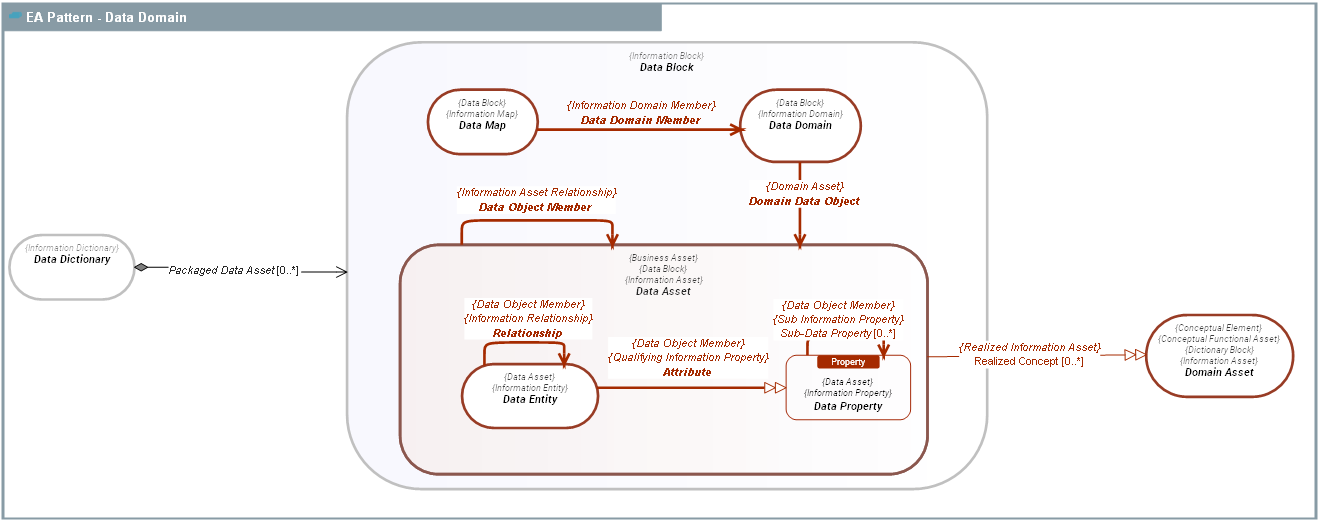CONCEPT DOMAIN - EA Pattern - Data Domain
| Description | Pattern Domain The EA Pattern - Data Domain comprises abstract concepts used to describe the logical and physical structure of Information Assets. |
|---|---|
| Dictionary |  Dictionary of SysFEAT concepts
Dictionary of SysFEAT concepts |
| Parent Domain | |
| Domain dependencies |  EA Pattern - Business Resource Operating Pattern
EA Pattern - Business Resource Operating Pattern  Enterprise Glossary
Enterprise Glossary  Information Assets
Information Assets  Information Packaging
Information Packaging |
DOMAIN CONCEPT GRAPH
Diagram Graph

CONCEPT DESCRIPTIONS
Abstract Concepts
| Concept | Description |
|---|---|
 Data Asset
Data Asset |
A Data Asset represents the abstract structure of any kind of data that can be processed and memorized by a Business Software System. A Data Asset is either a Data Entity or a Data Property. Only Data Entitys can have identity and states. Data Propertys only handle raw data. Data Assets are managed in Data Catalogs. |
 Data Block
Data Block |
A Data Block is an Information Block used for the description of data consumed and produced by Software Systems. They are defined in Data Dictionary(ies).
|
 Data Dictionary
Data Dictionary |
A Data Dictionary is a dictionary of Physical Data Blocks used to describe a data architecture. This includes: 1. Data Domains, 2. Data Entity(ies), 3. Data Property(ies). Concrete implementations are Logical Data Dictionary(ies), Relational Dictionary(ies), NoSQL Dictionary(ies). |
 Data Domain
Data Domain |
A Data Domain is subset of the enterprise’s data that are meant to be manipulated together in the context of business operations. For instance, a "Sales" Data Domain contains at least the following entities: Customers, Orders, Products. Each Data Entity in a Data Domain has CRUD characteristics. For instance, Products are read-only in a "Sales" Data Domain, while Customers and Orders have all CRUD characteristics. Data Domains define functional data boundaries used both for Data Allocation to Business Systems (see Data Stores) and Data Governance for data stewardship (Data Catalogs). |
 Data Entity
Data Entity |
A Data Entity is an abstract structure of an Information Entity. It has an independent existence and can be uniquely identified. Data Entity is characterized by Relationships it has with other Data Entity(ies) and by Value Property(ies). |
 Data Map
Data Map |
A Data Map is an urbanization tool for Data Asset. It represents a set of Data Domains in a particular context. |
 Data Property
Data Property |
A Data Property is a Data Asset that is fundamentally defined by its value. It doesn't evolve over time is thereby immutable. It represents a logical view of a data structure that stored in data stores. For instance an address or a customer name are usually considered as Data Property(ies). |
 Domain Asset
Domain Asset |
A Domain Asset is the representation of any type of tangible or intanglible resource, or its respective state, that is critical for comprehending an enterprise, including its data, resources, and activities. Similar to any Information Asset, a Domain Asset can be classified into three categories: 1) Conceptual Entitys denote entities that can change over time. 2) Event Concepts embody the temporal boundaries associated with Conceptual Entitys. 3) Concept Propertys represent immutable characteristics of Conceptual Entitys. |
 NIST - Data Asset
NIST - Data Asset Martin Fowler - Value Object
Martin Fowler - Value Object